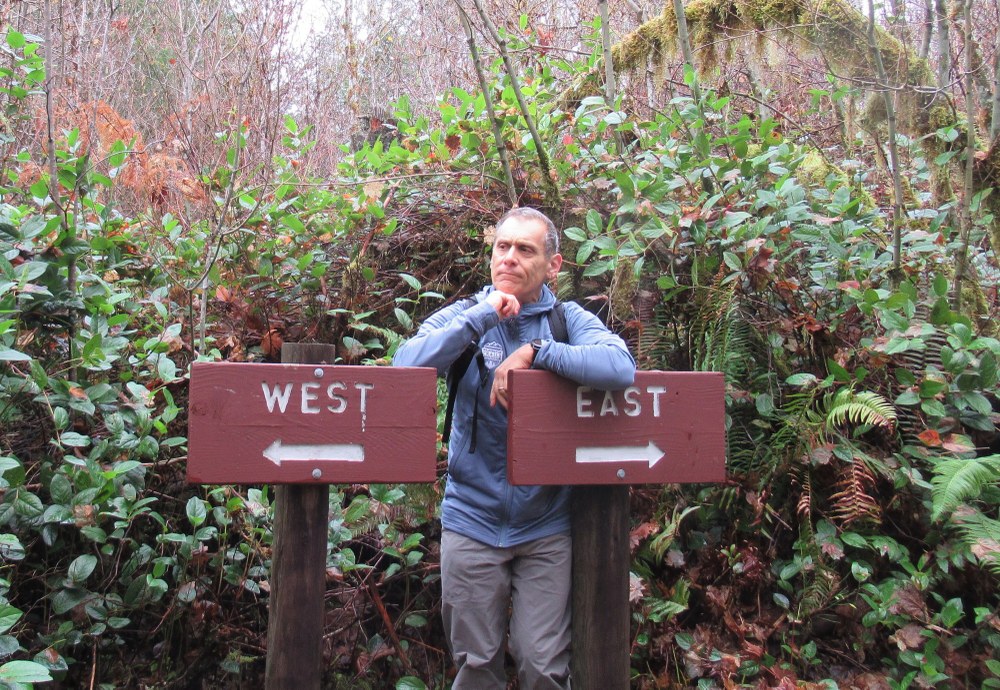
“Go West, young man,” heeded author and newspaperman, Horace Greeley, in 1865. It would become one of the most quoted phrases of the 19th century. And while its intent was rooted in the concept of Manifest Destiny, promising opportunities for homesteaders and industrialists at the expense of Native American sovereignty and environmental integrity, the phrase became a rallying call for Euro-Americans and an invitation to a better life than back East.
I was born and raised in New England. My early years were spent in a predominately Jewish and Italian neighborhood in Bridgeport Connecticut, an old industrial city 50 miles east of New York City. At age eight, my family moved to a town of 3,000 in New Hampshire. Now surrounded by nature, I bonded with the natural world and had no desire to live in the East’s urban areas. The forests, mountains, and lakes of New Hampshire and Vermont captivated me through my teens and twenties.
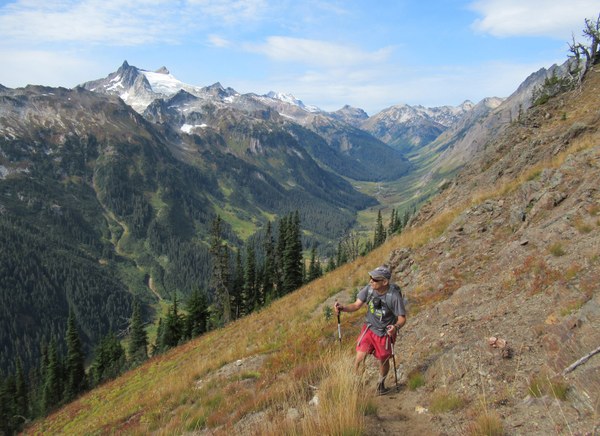 Craig at Little Giant Pass in the Glacier Peak Wilderness.
Craig at Little Giant Pass in the Glacier Peak Wilderness.
But while I contently traipsed through the backwoods of New England, the West still held an allure. I was drawn by the desire to see a wilder side of America, bigger mountains and wilderness areas, grizzly bears, wolves, orcas, old-growth forests, and large tracts of North America lacking settlements.
When a crisis struck me at age 28, I did what so many Eastern folks did before me: I headed West for an opportunity to start over. I had traveled the western half of the country prior and was particularly drawn to the Northwest. Despite its distance from New England, it held some similar traits with its forests and abundance of water. But the Appalachians and Cascades are two different beasts and the newness and excitement of the Northwest landscape enchanted me.
I fell in love with the glacier-capped volcanoes, wild coastline, roaring rivers, alpine meadows, and sprawling wilderness areas of the Northwest. But all the while, I also grew fonder for what I had left behind. The Northwest was no New England. It lacked the charm and quaintness I was accustomed to. It was a big boom town, its cities surrounded by huge tracts of urban sprawl. New England is well established and steeped in tradition, while the Northwest is a breeding ground of new technology disrupting the old order. Culturally, they are two different places with different ethnic make ups and very different vibes.
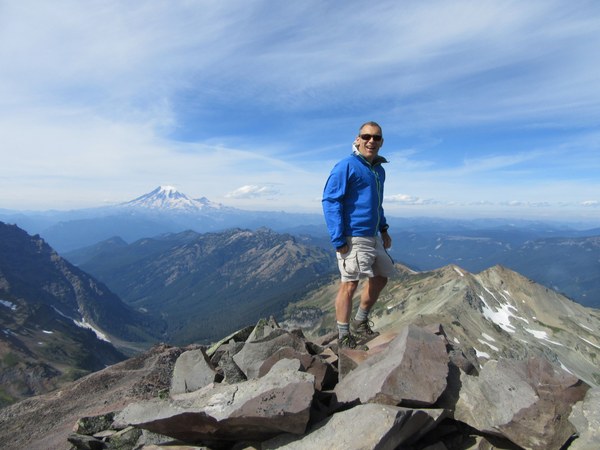 Craig at Old Snowy Mountain in the Goat Rocks Wilderness.
Craig at Old Snowy Mountain in the Goat Rocks Wilderness.
What also soon became evident is the illusion of the West as a polar opposite of the East. Most folks think of the East as crowded and urban, and the West as wild and open. But there are big cities in the West, and large rural tracts in the East. Western Washington is far more crowded and congested than northern New England, and there are more people in King County than in New Hampshire and Vermont combined.
While the West and East vary in many respects, their natural beauty elicit the same level of awe. Both hold me spellbound and bewildered, but the effects are different. The mountains of the Northwest are rugged, austere, awe-inspiring and in[1]your-face, while the mountains of the Northeast are rolling, rounded, soothing, and poetic. The old-growth, towering coniferous forests of the Northwest are massive pools of biomass that blow me away, while the stately hardwood forests of the Northeast are tanks of biodiversity that… also blow me away. Out West I love sharing habitat with mountain lions, wolves, and grizzly bears, but sharing habitat with moose, loons, spring peepers, and snapping turtles back East is just as satisfying and exciting.
While I did come West to start over, I came primarily for the promise of the mountains. I was not as interested in job opportunities (although the Northwest has been very good to me and I owe it thanks for my career) as I was in allowing the power of nature to heal my heart and restore my well-being. I have hiked thousands of miles in the Northwest’s mountains and am grateful for their rejuvenating qualities. And while nearly every hike here filled me with awe and fueled a sense of discovery, I soon realized that when I returned East to familiar mountains, they, too, soothed my soul and helped release my demons.
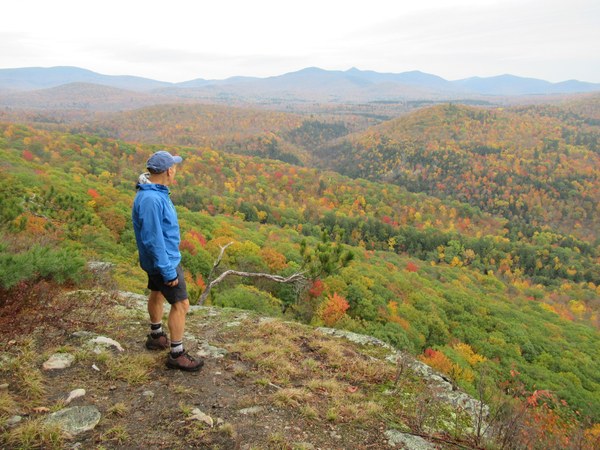 Craig at Rattlesnake Cliffs in the Green Mountain National Forest.
Craig at Rattlesnake Cliffs in the Green Mountain National Forest.
Nevertheless, I am continuously pressed by folks both West and East as to which area I like most, to which I answer, both. My feelings on this debate parallel my musical preferences. I like jazz, country, folk, and rock. They all bring me great pleasure. Being different genres, they cannot be compared, so I accept them for what they are and listen as my moods dictate. So, too, is how I feel about the mountains of New England and the Northwest. I am just as enthralled and bedazzled hiking across a Cascades alpine meadow bursting with blossoms in summer as I am hiking across a New England forest exploding with colors in autumn.
My East-West pull never abated. I became torn as to where my heart lies. Eventually I acquiesced to being bi-coastal, cherishing both the West and East for their unique attributes. I feel equally at home in both regions and savor every day I’m on the trail whether it be in Washington, Oregon, and British Columbia or New Hampshire, Vermont, and Maine.
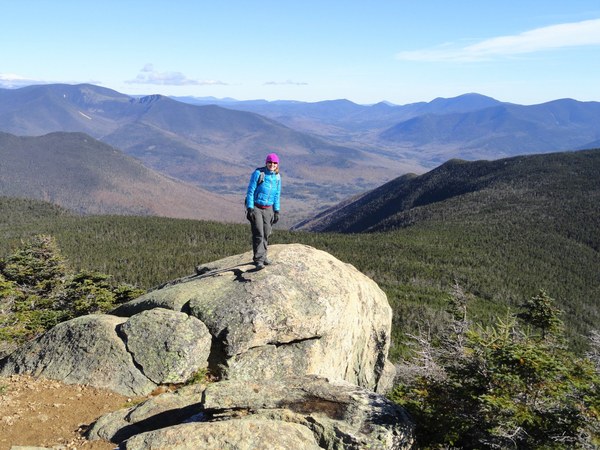 Craig's wife, Heather, on Mt. Flume in the Pemigewasset Wilderness.
Craig's wife, Heather, on Mt. Flume in the Pemigewasset Wilderness.
So, go West, East, North, or South my friend. But go with an open heart and mind. Accept the beauty around you and don’t be tempted to compare or quantify it. I have witnessed stunning landscapes and felt the sanctity of nature in the bayous of Alabama, the prairies of Saskatchewan, and the deserts of Southern California as much as I have on the rocky coast of Maine and the sparkling alpine lakes of the Cascades. The natural world in all of its facets is a special place that has sustained and instilled reverence to humans for thousands of years. As these special places — both East and West — become more threatened, we must see the beauty, sanctity, and life-sustaining importance of all of our natural places.
It was my desire to experience a different place that ironically helped establish my love for a place I once took for granted. Sometimes we don’t appreciate what we have until it’s gone. I pray to never have to lament the wild places of the Northwest and Northeast because we took them for granted, failed to worship them, and neglected to protect them.
Craig Romano is an award-winning guidebook author who has written more than 25 books, including Backpacking Washington, Day Hiking Central Cascades 2nd edition, and eight titles in the Urban Trails series (Mountaineers Books). Purchase his titles at our Seattle Program Center Bookstore, online, and everywhere books are sold.
This article originally appeared in our summer 2023 issue of Mountaineer magazine. To view the original article in magazine form and read more stories from our publication, visit our magazine archive.
 Craig Romano
Craig Romano